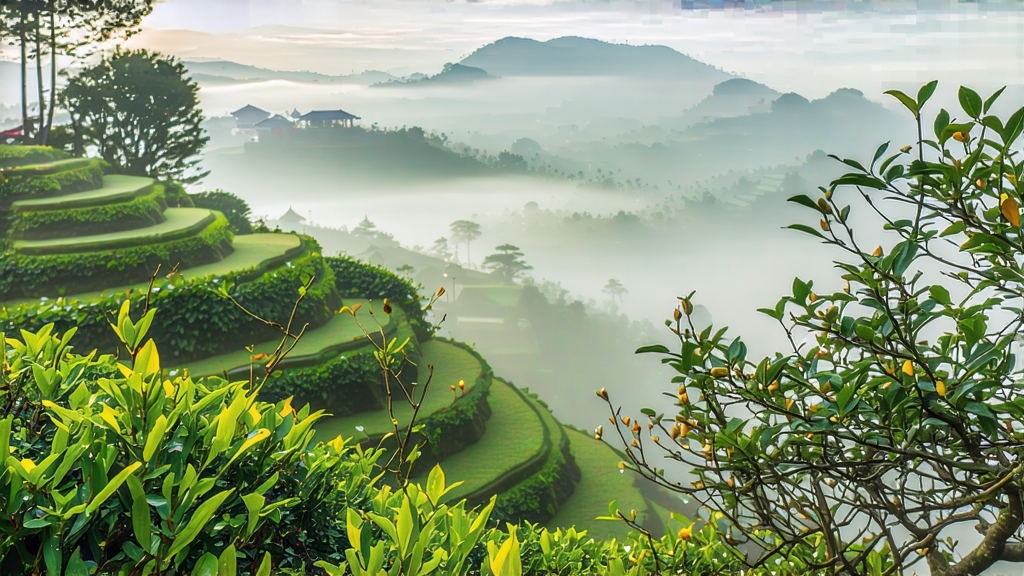
High above the fertile Chengdu Plain, where Sichuan’s misty clouds brush the shoulders of sacred peaks, lies a garden so venerable that its name is whispered like a prayer among Chinese tea elders: Meng Ding—literally “the Summit that Favors the Sky.” On this ridge, at roughly 1,450 m, the slow-drifting fog and the sharp swing between day- and night-time temperatures conspire to create a micro-climate ideal for one of China’s most elusive yellow teas, Meng Ding Huang Ya. Unlike its better-known green cousin Meng Ding Gan Lu, Huang Ya is a whispered secret, a tea whose production once vanished for decades and whose very existence now depends on a handful of families who still remember the exact moment when the leaf must be coaxed from green to gold.
Historical records first praise the tea during the Tang dynasty (618-907), when it was pressed into cakes and carried by mule train to Chang-an. By the Song era it had become “tribute of the first rank,” delivered to the emperor in tiny lacquered caddies sealed with yellow silk. Legend claims that when the imperial courier arrived at the palace gate the dew on the buds was still fresh, so quickly had the tea travelled down the Min River and along the post-roads. Yet the technique for making Huang Ya—especially the slow, anxiety-laden “sealed yellowing” step—was jealously guarded by monks of the Meng Ding temple. When the monastery declined in the Republican period the craft disappeared; the last known batch before modern revival was presented to Empress Dowager Cixi in 1908. Only in 1978 did a Sichuan agricultural delegation, digging through dynastic archives and interviewing octogenarian monks, succeed in reconstructing the process. Today fewer than 3,000 kg of authentic Meng Ding Huang Ya are produced each spring, most of it pre-sold to collectors in Beijing and Taipei before the snow has even melted.
The cultivar itself is a local heirloom called “xiao-ye zhong” (small-leaf stock) that has adapted to the mountain’s thin, slightly alkaline soil. After the Qingming festival, when the plateau nights still flirt with frost, pickers climb the terraces before sunrise to harvest only the unopened bud, occasionally accepting one just-unfurling leaf if it is still smaller than the bud itself. A seasoned plucker can gather barely 400 g in a dawn, the equivalent of 9,000 individual tips. The harvest is carried down the slope in shallow bamboo baskets lined with wild orchid leaves; the faint perfume is said to calm the leaf and foreshadow the floral note that will later bloom in the cup.
With yellow tea the margin between triumph and disaster is measured in minutes. The first step is a gentle pan-firing—called “sha qing” or killing-the-green—at 160 °C for no more than four minutes. The master’s bare hand sweeps the leaf against the iron surface in a motion known as “phoenix three nods,” feeling for the exact instant when the bud’s spine softens yet its downy coat remains un-scorched. Immediately the leaf is transferred to a wicker tray and placed above a charcoal brazier whose heat has been tempered by a slab of old volcanic stone. Here begins the “men huang,” the sealed yellowing that gives the tea its name and its soul. The buds are wrapped in thick linen bundles stacked no more than three layers deep; every forty minutes the cloth is unfolded, the leaf gently turned, and the bundles re-tied. Over six to eight hours the chlorophyll quietly oxidizes while amino acids convert into the chestnut-sweet compounds that will later coat the palate. The room must stay at 28 °C with 75 % humidity; too hot and the leaf reddens, too cool and the green stubbornly remains. Watching the master lift a corner of cloth to inspect the emerging amber rim is like witnessing alchemy.
Once the colour has shifted from jade to old gold the leaf is given a second, cooler firing at 90 °C to arrest enzymatic activity, then left to rest for a full day so that residual moisture migrates from stem to tip. A final low roast over embers of Chinese chestnut wood coaxes out the signature nut-cream aroma. The finished tea resembles tiny golden fish-hooks, each bristling with minute white hairs that catch the light like powdered brass. When rubbed between fingers the buds snap cleanly, releasing a scent that marries fresh corn silk with distant mountain orchid.
To brew Meng Ding Huang Ya you need calm water